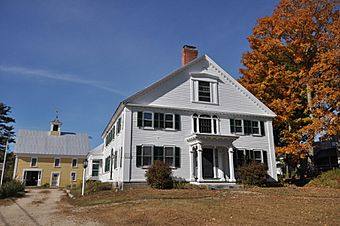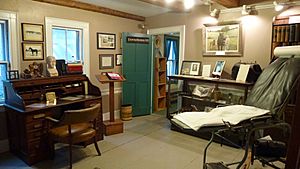Capt. Enoch Remick House facts for kids
Quick facts for kids |
|
|
Capt. Enoch Remick House
|
|
 |
|
| Location | 4 Great Hill Rd., Tamworth, New Hampshire |
|---|---|
| Area | 69 acres (28 ha) |
| Built | 1808 |
| Architectural style | Greek Revival, Federal |
| NRHP reference No. | 96000616 |
| Added to NRHP | June 3, 1996 |
The Captain Enoch Remick House is a special historic home in Tamworth, New Hampshire. It's part of a larger property that includes several old buildings and about 69 acres of land. In 1996, this entire property was added to the National Register of Historic Places. This means it's recognized as an important historical site in the United States. The house is important because of its art, its building style, and its connection to farming in the area. Today, it is open to visitors as the Remick Country Doctor Museum & Farm.
Contents
History of the Remick House
The story of the Remick House begins a long time ago. In 1779, a man named Enoch Remick bought 200 acres of land in Tamworth. His son, John Remick, who was a skilled carpenter, bought some of this land from his father and sisters. It is believed that John Remick built the first part of the house around 1808.
Captain Enoch Remick's Time
The house was later owned by Captain Enoch Remick, John's son. Captain Enoch was a very important person in Tamworth. He served as a state representative and a local leader. For about 20 years, from the 1830s to the 1850s, the third floor of the house was even used for town meetings! This was before Tamworth had its own town hall. Captain Enoch also ran an inn from the house for about 30 years. It was a popular stop for horses and travelers on the stagecoach route between Center Harbor and Conway.
The Remick Doctors
In 1867, Captain Enoch Remick sold the house to Nathaniel Hubbard Jr., who married Captain Enoch's daughter, Sarah. Their farm became one of the largest in town. After Sarah passed away, her nephew, Dr. Edwin Remick, bought the house in 1904.
Dr. Edwin Remick was a "country doctor," meaning he provided medical care to people in the countryside around Tamworth. He lived on the second floor of the house and ran his medical office from the first floor. In 1929, his son, Edwin Crafts Remick, who was also a doctor, joined his father's practice. Dr. Edwin Crafts Remick continued to run the medical practice and the farm until he passed away in 1993. He even had the first milk pasteurization facility north of Rochester. Before he died, Dr. E.C. Remick made sure the farm and historic home would be preserved as a museum for everyone to learn from.
Building Style and Art
The Captain Enoch Remick House shows different building styles because it was changed and added to over many years. It was first built around 1808 in the Federal style. Later, around 1830 and again around 1850, it was updated with features from the Greek Revival style.
You can see these different styles in the doors, windows, and even the fireplaces inside the house. Some rooms have tin ceilings that were added later in the 1800s. A special window called a Palladian window is above the south entrance. It has a unique design with arched sections.
Wall Murals
One of the most interesting things inside the house is the wall murals. These are paintings directly on the walls! They are believed to have been painted by a traveling artist named John Avery. His paintings often included "lumpy" hills, trees grouped together, and bunches of grapes. In the doctors' pharmacy room, there's a painting of a stagecoach. This mural might have been painted to remember that the house used to be a stagecoach stop.
Remick Country Doctor Museum & Farm
The Captain Enoch Remick House is now part of the Remick Country Doctor Museum & Farm. This museum teaches visitors about medical history, farming in New England, and what life was like for a country doctor. They have exhibits, demonstrations, and special programs.
The museum property includes several buildings:
- A museum center inside a historic farmhouse.
- A cattle barn.
- A milk house.
- A maple sugar house (where maple syrup is made).
- An ice house.
- A stable.
Besides being a museum, it's also a working farm! They have chickens, pigs, sheep, goats, and cows. They also grow hay in fields around Tamworth.
Visitors can take tours inside the Captain Enoch Remick House. The inside has been kept mostly as it looked in the late 1800s. You can see the doctors' pharmacy and medical office, a screened-in porch, and where the elder Dr. Remick lived.
See also




